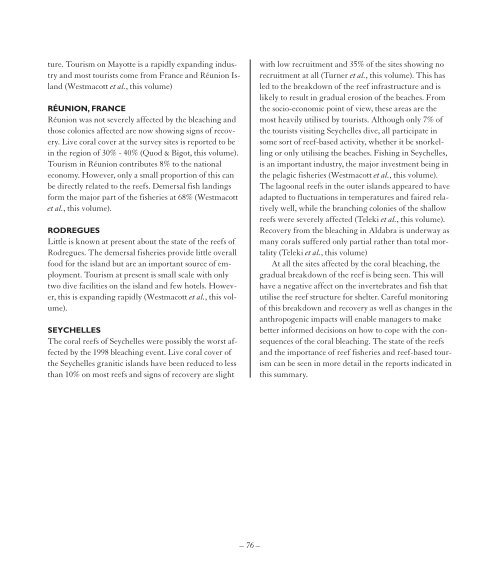You also want an ePaper? Increase the reach of your titles
YUMPU automatically turns print PDFs into web optimized ePapers that Google loves.
ture. Tourism on Mayotte is a rapidly expanding industry<br />
and most tourists come from France and Réunion Island<br />
(Westmacott et al., this volume)<br />
RÉUNION, FRANCE<br />
Réunion was not severely affected by the bleaching and<br />
those colonies affected are now showing signs of recovery.<br />
Live coral cover at the survey sites is reported to be<br />
in the region of 30% - 40% (Quod & Bigot, this volume).<br />
Tourism in Réunion contributes 8% to the national<br />
economy. However, only a small proportion of this can<br />
be directly related to the reefs. Demersal fish landings<br />
form the major part of the fisheries at 68% (Westmacott<br />
et al., this volume).<br />
RODREGUES<br />
Little is known at present about the state of the reefs of<br />
Rodregues. The demersal fisheries provide little overall<br />
food for the island but are an important source of employment.<br />
Tourism at present is small scale with only<br />
two dive facilities on the island and few hotels. However,<br />
this is expanding rapidly (Westmacott et al., this volume).<br />
SEYCHELLES<br />
The coral reefs of Seychelles were possibly the worst affected<br />
by the 1998 bleaching event. Live coral cover of<br />
the Seychelles granitic islands have been reduced to less<br />
than 10% on most reefs and signs of recovery are slight<br />
with low recruitment and 35% of the sites showing no<br />
recruitment at all (Turner et al., this volume). This has<br />
led to the breakdown of the reef infrastructure and is<br />
likely to result in gradual erosion of the beaches. From<br />
the socio-economic point of view, these areas are the<br />
most heavily utilised by tourists. Although only 7% of<br />
the tourists visiting Seychelles dive, all participate in<br />
some sort of reef-based activity, whether it be snorkelling<br />
or only utilising the beaches. Fishing in Seychelles,<br />
is an important industry, the major investment being in<br />
the pelagic fisheries (Westmacott et al., this volume).<br />
The lagoonal reefs in the outer islands appeared to have<br />
adapted to fluctuations in temperatures and faired relatively<br />
well, while the branching colonies of the shallow<br />
reefs were severely affected (Teleki et al., this volume).<br />
Recovery from the bleaching in Aldabra is underway as<br />
many corals suffered only partial rather than total mortality<br />
(Teleki et al., this volume)<br />
At all the sites affected by the coral bleaching, the<br />
gradual breakdown of the reef is being seen. This will<br />
have a negative affect on the invertebrates and fish that<br />
utilise the reef structure for shelter. Careful monitoring<br />
of this breakdown and recovery as well as changes in the<br />
anthropogenic impacts will enable managers to make<br />
better informed decisions on how to cope with the consequences<br />
of the coral bleaching. The state of the reefs<br />
and the importance of reef fisheries and reef-based tourism<br />
can be seen in more detail in the reports indicated in<br />
this summary.<br />
– 76 –


















